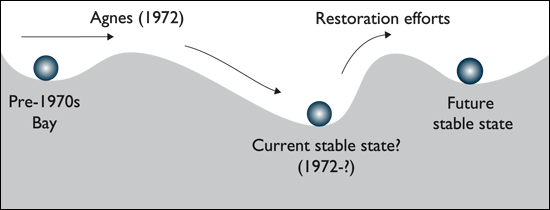![[Chesapeake Quarterly masthead]](/images/uploads/siteimages/imported/masthead.gif)
![[Chesapeake Quarterly masthead]](/images/uploads/siteimages/imported/masthead.gif) |
|
2004
|
Volume 3, Number 3
|
Table of Contents
|
Subscribe
|
Download pdf
|
The Language of ResilienceResilience is a formal theoretical construct that has its roots in dynamic systems theory — the body of math that characterizes the behavior of complex systems. Ecologists use two different definitions of the term: engineering resilience and ecological resilience. Engineering resilience is defined as the rate at which a system returns to a stable state following a perturbation. This assumes that a system does not, after a perturbation, shift into an alternate state. Ecological resilience, in contrast, is measured by the magnitude of disturbance that can be absorbed before the system changes its structure. This definition applies both to ecological and social systems and it assumes from the outset that there exist multiple stable states for any given system. The Resilience Alliance has adopted the definition of ecological resilience as the foundation for its exploration of the dynamics of ecological-social systems. They assert that ecological resilience is a better fit because "the interplay between stabilizing and destabilizing properties is at the heart of present issues of development and the environment — global change, biodiversity loss, ecosystem restoration and sustainable development." In contrast, "emphasis on engineering resilience reinforces the dangerous myth that the variability of natural systems can be effectively controlled, that the consequences are predictable and that sustained production is an attainable and sustainable goal." The diagram below illustrates ecological resilience in the context of the Chesapeake Bay. Ecological resilience forms the operative framework for this story. 
Despite deforestation and diminished wetlands, until the 1970s the Chesapeake Bay existed in a stable state with abundant fish, shellfish and underwater grasses. Over time, however, the accumulated loss of oysters, forests and other buffers weakened its resilience and left the Bay vulnerable to the torrential runoff brought by Tropical Storm Agnes in 1972. Since then, many ecologists feel that the Bay has found a new steady state, but one with far fewer grasses and many more algal blooms. Getting to a state that more closely resembles the past will require a difficult push up a hill made steeper by the loss of the Bay's buffers.
Diagram adapted from Gunderson, Lance H. 2000. Ecological resilience-in theory and application. |
|
|
Top of Page |
|
|
Home |
Contents |
Other Issues |
|
|
|
||||
![[Maryland Sea Grant]](/images/uploads/siteimages/imported/h_footer_mdsg.gif) ![[NOAA]](/images/uploads/siteimages/imported/h_footer_noaa.gif) |
This page was last modified November 03, 2004 |